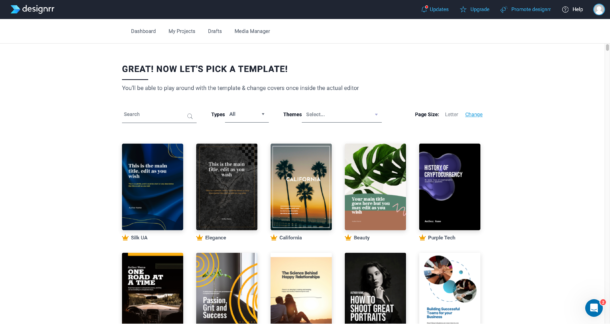Why most professionals struggle to stand out as experts?
Some professionals and businesses seem to effortlessly attract opportunities. You notice them quoted in industry publications, invited to speak at conferences, and commanding premium rates. Their secret?
Thought leadership stands behind their success. They aren’t necessarily smarter than you – they’ve simply packaged and shared their expertise effectively.
Professionals across dozens of industries has shown a consistent pattern. People who systematically share valuable insights attract better opportunities than those who keep their knowledge to themselves.
Unfair?
Perhaps.
Reality?
Absolutely.
Ebooks serve as one of the most powerful and underutilized tools for establishing yourself as a go-to authority in your field. Whether you work as a consultant, own a business, or want to advance your career, a well-crafted ebook can transform how your audience perceives you.
Most ebooks fail to make an impact because they come across as too basic, overly self-promotional, or simply forgettable. This guide explores what separates ebooks that establish real thought leadership from those that collect digital dust.
How Ebooks Capture Attention When Everything Else Gets Ignored

Someone who downloads your ebook gives you something incredibly rare in today’s world: dedicated time with their undivided attention. Unlike social media posts scrolled past or blog articles skimmed, an ebook creates a focused engagement space – just you and your reader having a deep conversation about a topic they care about.
Think about the last time you downloaded an ebook. You likely wanted a complete understanding of something important to you. That same mindset drives your readers – active seekers of expertise rather than passive content consumers.
The ebook format allows you to show intellectual depth impossible to achieve in shorter formats. You can explore nuances, address complexities, and showcase your full range of thinking – something a 500-word blog post or LinkedIn update simply cannot accomplish.
The benefits extend far beyond the immediate reader experience:
Pre-educated audience. Complex services and ideas require educated clients and followers. An ebook helps people understand your approach before you ever talk to them, making conversations more productive.
Visible thinking process. Your ebook reveals how you think, solve problems, and communicate – factors that often influence people’s decisions to work with you more than past achievements alone.
Permanent intellectual property. Unlike disappearing social media content, ebooks create lasting intellectual assets that continue driving interest and establishing authority years after publication. Inquiries still come in from an ebook I published three years ago.
Professional positioning boost. The “author” title changes how people perceive you. Even in our digital world, writing a “book” (even an electronic one) carries weight other content formats lack.
Research confirms these benefits. Thought leaders command rates 15-30% higher than peers with equivalent skills but no established thought leadership platform. They spend less on marketing because opportunities come to them, and typically enjoy greater career stability and advancement.
Ebooks deliver powerful results, yet few people create them because doing it right takes work. The return on investment makes the effort worthwhile.
How to Discover Your Unique Expertise That Others Will Value
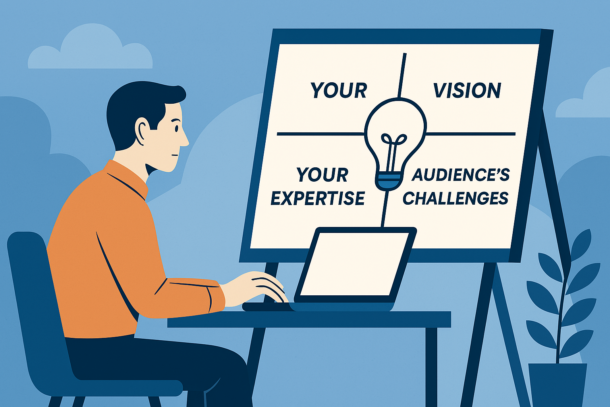
Many people jump straight into writing without first identifying their unique intellectual territory. Starting to write about “leadership best practices” or “digital marketing trends” puts you in competition with thousands of nearly identical pieces.
Map your unique “thought space” – the territory you can credibly claim as your own – before writing a single word. Your thought space exists at the intersection of four elements:
- Your Expertise and Experience: What specific knowledge do you possess that others don’t? What experiences give you uncommon perspective?
- Your Audience’s Challenges: What problems keep your ideal readers up at night? What frustrates them most?
- Market Gaps: What topics appear either over-simplified or needlessly complicated in existing content?
- Your Vision: What future direction do you see that others miss? Where do you predict your industry will head next?
Create a simple four-quadrant matrix to find this intersection:
First quadrant: List common topics with common perspectives – things everyone in your industry discusses in predictable ways. Avoid this territory.
Second quadrant: Note common topics where you hold fresh perspectives – popular subjects where your view differs from mainstream thinking. This territory shows promise.
Third quadrant: Identify emerging topics with common perspectives – new areas where few people offer comprehensive coverage, even if your take aligns with others.
Fourth quadrant: Explore emerging topics with fresh perspectives – new issues where you possess distinctive viewpoints. This quadrant offers gold mine territory for thought leadership.
A healthcare professional struggling to stand out in the crowded wellness space identified her unique thought space through this exercise: “Microbiome optimization for mental health performance.” This intersection combined her specialized knowledge, addressed growing interest in mental wellness, filled a gap in practical guidance, and aligned with her vision of healthcare’s future direction.
What territory can you claim that aligns with your expertise and audience needs while setting you apart from others?
The Pain Points Your Audience Actually Cares About
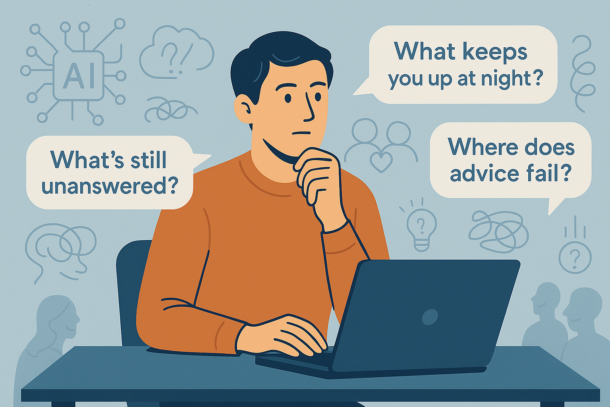
Generic topics produce generic ebooks. Compelling thought leadership requires identifying specific tensions your ideal audience experiences – urgent problems lacking good solutions.
You’ve likely experienced that frustration of searching for information on a pressing problem, only to find surface-level advice that offers little help. That exact frustration creates the opportunity for your thought leadership.
Talk to the people you want to reach to identify these tensions. Formal research isn’t necessary – casual conversations often reveal valuable insights. Ask questions like:
“What work challenge keeps you up at night that people rarely discuss publicly?”
“Where does conventional wisdom in your industry contradict your actual experience?”
“What question remains unanswered despite checking your usual resources?”
“What upcoming decision makes you least confident given your current information?”
Patterns in these responses reveal rich territory for thought leadership directly connected to real needs. Conversations with financial services professionals revealed an unexpected tension: how to adopt AI tools while maintaining the human relationships that set them apart. This insight sparked an ebook generating more engagement than anything previously published.
Pay attention to questions people repeatedly ask you. What information do clients, colleagues, or followers consistently seek from you? These repeated questions often signal gaps you can uniquely fill.
Focus on finding specific tension points where your expertise provides clarity and direction others can’t offer rather than trying to address every possible topic.
The Three-Part Structure That Makes Readers Trust Your Expertise
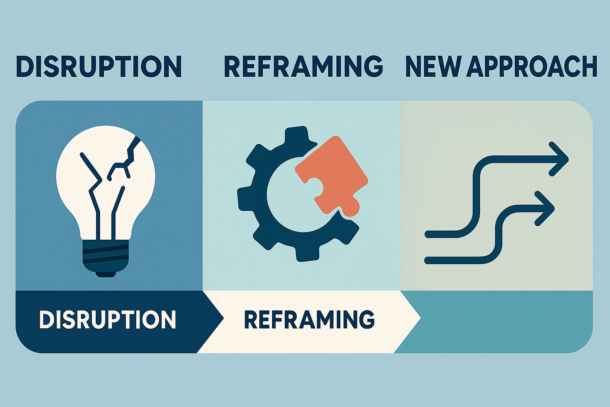
The structure of your ebook matters as much as its content. Effective thought leadership ebooks follow a specific architecture that challenges conventional thinking and presents fresh perspectives.
The “Disruption → Reframing → New Approach” model works powerfully:
Challenge existing assumptions or approaches within your industry first. This creates cognitive tension that captures attention and opens your audience to new thinking. Rather than publishing another basic guide on personal finance, open with “Why traditional retirement planning fails modern professionals.”
Introduce a new framework for understanding the problem after disrupting existing perspectives. Offer a constructive alternative way of thinking, not just criticism. Our financial example might continue with “The Dynamic Financial Independence Framework: Planning for Flexibility, Not Just Security.”
Show how your framework translates into practical action with specific implementation guidance. Transform your thinking from interesting theory to useful application. Complete your financial ebook with “Implementing Dynamic Financial Planning: Five Steps to Start Today.”
This structure positions you as both a diagnostician of problems and a provider of solutions – exactly what people seek from trusted experts.
Your ebook should follow a narrative arc that builds authority within this overarching structure:
Demonstrate deep understanding of today’s environment. Show readers you truly understand their world before asking them to consider new perspectives.
Analyze the forces creating new challenges or opportunities. Help readers understand why traditional approaches lose effectiveness and why change becomes necessary.
Present your fresh framework or methodology. Make your unique intellectual contribution shine here.
Provide concrete examples showing your approach in practice. Make abstract concepts tangible.
Offer specific implementation guidance. Give readers clear next steps for applying your thinking.
Explore future implications to position yourself as forward-thinking. Create openings for ongoing engagement.
This structure respects the reader’s journey – meeting them where they are, guiding them through new thinking, and leaving them with practical guidance and a memorable framework for immediate application.
Four Types of Research That Make Your Ideas Credible
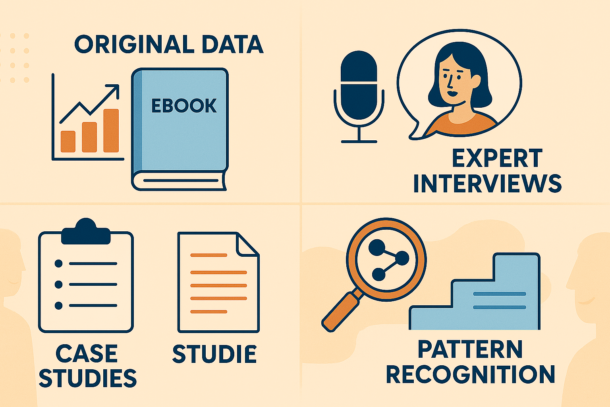
Evidence separates genuine thought leadership from mere opinion.
Your ebook needs substantive research to establish authority rather than merely assert viewpoints. The good news? You don’t need a research department or big budget to include compelling evidence. Try these approaches:
1. Original Data Collection
Valuable data might already exist at your fingertips. Examine your client work, project history, or personal experiences. Look for patterns across cases that might yield insights.
Even modest original research significantly sets your perspective apart. One consultant analyzed just 15 past projects, identifying surprising patterns in implementation success factors that became his thought leadership foundation.
A simple survey of your network, clients, or social media followers can also work well. Even 30-50 responses reveal interesting patterns if you ask the right questions.
2. Expert Interviews
Conversations with diverse experts strengthen your ebook considerably. Contact colleagues, clients, or industry connections for 30-minute topic interviews.
Ask thoughtful questions that go beyond obvious answers. Replace “What are best practices for X?” with “Where does conventional wisdom about X fail in actual practice?” or “What contradictions exist between what people recommend and what actually works regarding X?”
Include interview quotes throughout your ebook to add credibility and diverse perspectives. This approach expands your ebook’s reach as those interviewed typically share the final product with their networks.
3. Case Studies
Specific examples transform abstract ideas into concrete understanding. Develop 2-3 detailed case studies that illustrate your thinking in action.
Effective case studies follow this structure:
- The specific challenge or situation
- The approach and thinking process
- The implementation details
- The results and lessons learned
Anonymized case studies still show your thinking process and results achieved even when you can’t name specific clients.
4. Pattern Recognition
Connect separate developments into meaningful patterns for sophisticated thought leadership. Look for connections between trends in your industry and adjacent fields. Consider how developments in technology, consumer behavior, or business models might affect your area of expertise.
One financial advisor created a compelling ebook by connecting demographic trends, technological developments, and regulatory changes into a coherent vision for evolving retirement planning. This synthesis demonstrated intellectual capability beyond simply reporting existing information.
Your goal isn’t academic-style exhaustive research. Provide enough evidence to support your perspective and show deeper thinking than commonly available sources.
How to Create Frameworks Your Readers Will Actually Remember
Proprietary frameworks – organizational structures for thinking about problems associated with your name and brand – form the most valuable component of thought leadership.
Consider frameworks that have influenced your field: the 4 Ps of Marketing, the Good to Great model, or SMART goals. These simple yet powerful structures help people organize their thinking and take action while creating language people associate with their creators.
Several framework types prove particularly effective:
Assessment Matrices: Help people evaluate options or approaches by plotting two important variables against each other. One leadership coach created the “Energy/Focus Matrix” for evaluating activities based on whether they energized you and leveraged your unique strengths. This quadrant became her signature tool and constant client reference point.
Process Models: Provide step-by-step approaches to solving problems. A sales trainer developed the “5A Conversion Process” (Acknowledge, Ask, Align, Address, Advance) that became his signature methodology and organizing principle for all training materials.
Decision Trees: Guide people through complex choices via a series of simpler questions. A business strategist created a “Market Entry Decision Tree” that helped entrepreneurs evaluate new opportunities based on their specific resources and objectives.
Capability Maturity Models: Define progression stages in a particular skill or function. A marketing consultant developed a “Content Marketing Maturity Model” with five levels from “Reactive” to “Transformative” that helped clients assess their current state and create improvement plans.
The best frameworks possess certain qualities: simple enough to remember yet robust enough for practical use; clear, distinctive language; and versatility for various situations.
Creating your own framework seems less intimidating when you look for patterns in your approach: How do you consistently solve problems? What factors do you always consider? What steps do you typically follow? The framework often already exists in your practice – you simply need to make it explicit and give it a memorable name.
A financial planner realized she always evaluated client situations through three perspectives: cash flow management, risk mitigation, and growth optimization. She developed this into the “Financial Triangle” framework that became central to her client communications and thought leadership ebook.
What framework could you develop that captures your approach and provides value to your audience?
How to Sound Smart Without Boring Your Readers
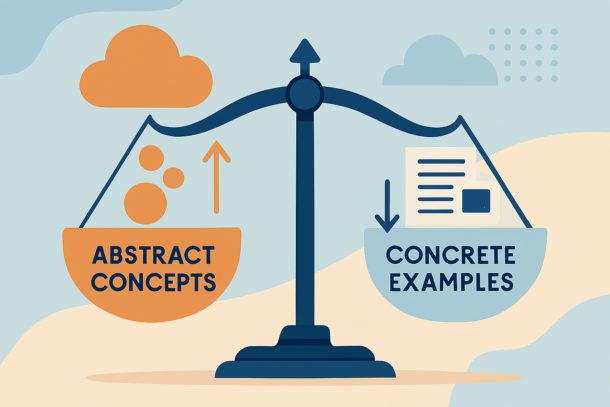
Thought leadership requires critical content balance – sophisticated thinking presented in an accessible, engaging manner. Too academic loses readability; too simplistic fails to establish authority.
Strike that balance with these approaches:
Mix Concrete and Abstract
Move up and down a ladder in your writing. Big concepts and theories sit at the top. Specific examples and stories rest at the bottom. Engaging thought leadership constantly connects these levels, linking big ideas to concrete realities.
Start with a concept: “Digital transformation requires cultural change more than technological investment.” Move down to a specific strategy: “Leadership teams must model the digital-first behaviors they want throughout their organizations.” Continue to a tactical recommendation: “Executives should conduct virtual meetings using the same tools expected for team adoption.” Ground everything in a specific example: “Manufacturing client Westbrook required all executive updates submitted through their new digital platform rather than email, increasing adoption rates across the organization by 64% within three weeks.”
This movement between levels connects with different reader types. Some grasp concepts first, while others need concrete examples to understand.
Use Conversational Expertise
Make your writing voice signal expertise without creating distance. Use precise terminology when it adds clarity, but avoid jargon that creates barriers.
Include thoughtful qualifiers acknowledging nuance: “This approach works particularly well for service-based businesses, though product companies might need to adjust the timeline.” These qualifications demonstrate sophisticated understanding without academic complexity.
Reference relevant context: “This might seem similar to the agile methods that changed software development, yet it specifically addresses the challenges of creative workflows.” This contextual awareness signals knowledge depth.
Define technical terms briefly when used: “The customer acquisition cost (CAC) – what you spend to acquire a new customer – should compare directly to their lifetime value.” This ensures readers follow your thinking without feeling excluded.
Tell Stories with a Purpose
Stories make complex ideas accessible. They create emotional connection while illustrating concepts in action. Thought leadership stories need clear purpose, however.
Structure stories with these elements when working with experts developing ebooks:
- The situation or challenge making the story relevant
- The conventional approach and its shortcomings
- The insight or thinking shift that changed the approach
- The implementation details and differentiating factors
- The results and broader lessons
A cybersecurity expert shared how a client followed all standard security protocols yet still experienced a breach. The story illustrated his framework about human-centered security being equally important as technical measures. The narrative demonstrated his expertise while teaching a valuable lesson without preaching.
Which stories from your experience could illustrate your key frameworks or insights?
Read our complete ebook mistakes and how to avoid them article.
Visual Elements That Make Your Ebook Look Professional
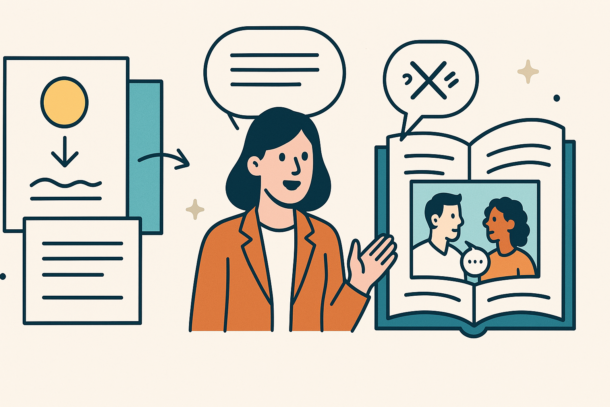
Visual presentation significantly impacts how readers perceive your expertise. People make judgments about your credibility based on how your content looks, whether fair or not.
Create an impressive ebook without professional design skills by focusing on these key elements:
Clean, Consistent Formatting
Establish a limited set of styles for headings, body text, quotes, and callouts – then apply them consistently. Inconsistent formatting creates a subconscious impression of disorganized thinking.
Allow adequate white space to give your content room to breathe. Dense, crowded pages overwhelm readers before they start reading.
Limit yourself to 1-2 fonts – typically one for headings and potentially a different one for body text. Multiple fonts create visual chaos.
Strategic Use of Visuals
Make visuals clarify and enhance your ideas rather than merely decorate pages. Use diagrams to explain concept relationships, charts to illustrate data, and process flows to show sequences.
Give your proprietary frameworks special visual treatment. Create distinctive visual representations readers will associate with your ideas.
Compare these options: explaining your three-phase approach in text alone, or including a simple professional diagram that makes the relationship between phases immediately clear. The visual approach almost always creates more impact.
Professional Cover Design
Your cover creates the first impression. A clean, modern design with your title, subtitle, and name often works better than complicated imagery. The cover doesn’t need elaborate design but should look intentional and align with your brand.
Services like Canva offer templates if design falls outside your strengths, or hire a freelance designer on platforms like Fiverr specifically for your cover – a worthwhile investment.
Or use an ebook creator like Designrr, which guides you through every step from idea generation to the completed ebook.
Try and sign up for Designrr’s special offer today!
Still considering? Compare us with Canva, or check out our best ebook software or best AI writing tool for ebooks.
Thoughtful Layout
Create a clear information hierarchy through consistent heading structures. This helps readers navigate your content and understand relationships between ideas.
Consider how readers will experience information flow. Use page breaks intentionally to separate major sections and provide natural pausing points.
Include a professional table of contents allowing readers to navigate to specific sections of interest.
Your design choices signal your attention to detail and professionalism. A well-designed ebook tells readers: “I care about your experience and take my expertise seriously enough to present it well.”
How to Get Your Ebook in Front of the Right Audience
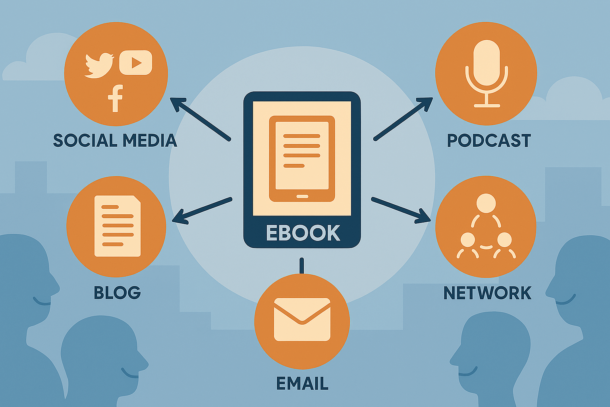
Strategic distribution ensures your ebook reaches and impacts your target audience after creation.
The Gating Question
Decide whether to “gate” your ebook behind an email signup form. Valid arguments exist for both approaches:
Gating builds your email list and creates value perception through exchange. It helps track who shows interest in your content and enables appropriate follow-up.
Removing restrictions maximizes reach and eliminates friction from the reading experience. This approach generates more goodwill and broader awareness.
The best approach depends on your current goals and audience size. Make your first ebook freely available to maximize exposure when just building your platform. Gate premium content while keeping shorter resources open as your audience grows.
A hybrid approach often works well: offer a valuable executive summary or first chapter freely, with complete ebook access through registration. This gives people a taste of your thinking before requesting their information.
The Hub and Spoke Model
Consider your ebook the hub of a content ecosystem, with various “spokes” extending its reach:
Create blog posts highlighting key ebook concepts, each linking to the full download.
Develop social media content extracting compelling quotes, statistics, or frameworks from your ebook.
Record short videos or podcast episodes discussing central ebook ideas.
Offer interviews on relevant podcasts or write guest articles for industry publications based on your ebook content.
Create visuals showcasing key frameworks or data for sharing across platforms.
This model multiplies your ebook’s impact by meeting people where they are with their preferred content formats.
Using Your Network
Your existing network often provides the best distribution starting point. Personal outreach proves incredibly effective:
Send individual messages to colleagues who would find specific ebook sections valuable. Replace generic announcements with personalized notes: “I just published an ebook, and chapter 3 on [topic] might particularly help with the challenge you mentioned about [specific situation]. I’d appreciate your thoughts if you have time to review it.”
Create a simple “launch team” of supporters who agree to share your ebook with their networks. Provide sample language and visuals they can use easily.
Contact organizations or communities where your expertise would provide value and offer your ebook as a resource for their members.
Ebook distribution continues as an ongoing process rather than a one-time event. Some of your most valuable readers will discover your ebook months or years after initial publication.
How to Measure the True Impact of Your Thought Leadership
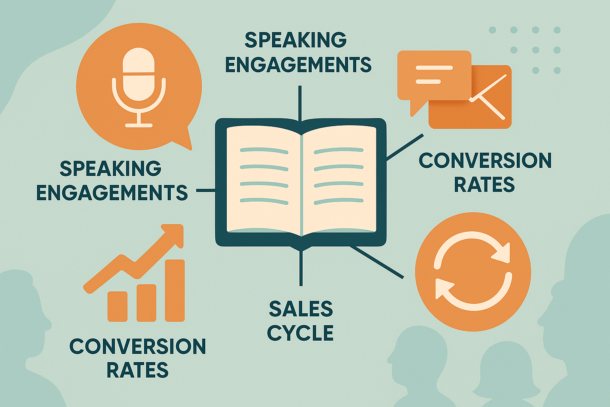
Look beyond download numbers to measure real impact and determine if your ebook establishes thought leadership.
Impact Indicators
Meaningful signs of thought leadership impact include:
- Speaking invitations or requests to contribute to industry publications
- Direct inquiries specifically mentioning concepts from your ebook
- People referencing your frameworks or ideas in their content
- Improved conversion rates in business development
- Shorter sales cycles as prospects come pre-educated
- Premium rate opportunities for your services
- Inquiries from higher-quality prospects aligned with your ideal client profile
One consultant’s ebook generated only 250 downloads in its first year – initially disappointing him. However, three major clients specifically cited his innovative framework as their reason for reaching out. Those three relationships generated more revenue than all his other marketing efforts combined.
From One Book to an Ongoing Program
The most powerful thought leadership builds a sustained program that grows over time rather than relying on a single ebook. Your first ebook can become the foundation for an ongoing platform:
- Create annual updates or expanded editions incorporating new developments
- Develop complementary ebooks exploring specific methodology aspects in greater depth
- Build a series addressing different aspects of larger challenges facing your audience
- Create workbooks or implementation guides helping readers apply your frameworks
This approach deepens your authority while engaging your audience with fresh content. It also creates multiple entry points for new readers to discover your work.
Listening and Adapting
Pay close attention to audience responses to your ebook:
- Which concepts or frameworks generate the most questions or comments?
- What sections do people reference most frequently in discussions?
- Where do readers express confusion or ask for clarification?
- What additional questions emerge after people read your content?
These responses provide invaluable guidance for growing your thought leadership. A financial advisor publishing an ebook on retirement planning noticed readers consistently asked how his approach applied to entrepreneurs. This insight led to his second ebook, which achieved even greater success because it addressed a specific need identified through feedback.
Four Simple Ways to Find Time for Your Ebook
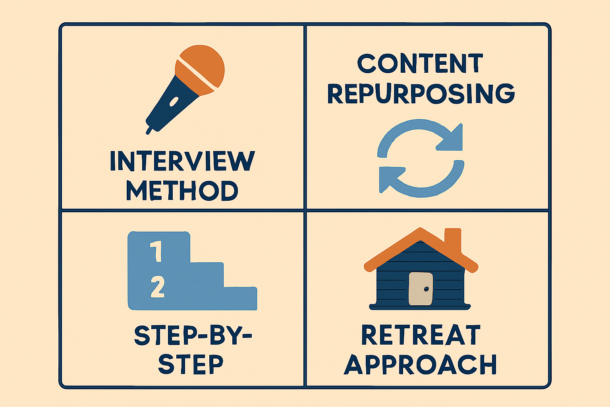
“This sounds great, but when would I find time to create an ebook?” This question represents the most common obstacle busy professionals mention. Consider these practical approaches:
1. The Interview Method
Have someone interview you about your topic instead of writing from scratch. Record these conversations, transcribe them, and use the transcripts as raw material for your ebook. This approach often captures your natural voice and makes writing much less daunting.
One consultant blocked three two-hour interview sessions with a writer who asked thoughtful questions about his methodology. Those six hours of conversation produced the raw content for his entire ebook, which the writer then organized and edited into a cohesive manuscript.
2. The Content Repurposing Approach
Examine content you’ve already created – blog posts, presentations, client resources, internal documents. These might combine and expand into an ebook framework. You’ve likely developed more material than you realize.
One financial planner had created detailed email responses to common client questions over years. She collected these emails, organized them thematically, and expanded them into a comprehensive ebook with relatively little additional writing.
3. The Step-by-Step Strategy
Break your ebook into small, manageable components instead of attempting creation in one heroic push. Commit to writing just one section per week over several months. This approach makes the project sustainable alongside other responsibilities.
A busy executive committed to writing for just 30 minutes each morning before his workday began. Using a detailed outline, he focused on one small section at a time. After four months, he completed a full ebook without feeling overwhelmed by the project.
4. The Retreat Approach
Some people prefer dedicated concentrated time for their ebook. Schedule a personal retreat – even just a weekend at a local hotel – to focus exclusively on developing content without everyday distractions.
A production method that fits your life works better than trying to reorganize your life around an ideal writing process. Which approach aligns with your schedule and working style?
How to Make Complex Ideas Clear Without Dumbing Them Down

Finding the right balance between demonstrating expertise and remaining accessible to readers who don’t share your specialized knowledge presents another common challenge.
Genuine expertise involves making complex ideas understandable and actionable for others rather than using complex language or displaying knowledge breadth.
Terms and concepts you use daily may seem unfamiliar to others when deeply immersed in your field. Ask someone outside your field to review early content drafts and identify any jargon or concepts needing explanation.
Concrete examples serve as your best tools for making abstract ideas accessible. Follow any complex concept introduction with a specific example or story illustrating it in action.
A brief glossary for necessary technical terms helps readers who might be unfamiliar with these concepts. This allows precise terminology use without losing readers new to these ideas.
How to Push Past Self-Doubt When Sharing Your Ideas

“Who am I to position myself as an expert? What if people criticize my ideas?” These questions represent perhaps the most universal challenge in creating thought leadership.
These concerns appear so commonly that they constitute a normal part of the thought leadership journey. Even recognized field experts often experience these doubts when sharing their ideas publicly.
Thought leadership means sharing your unique perspective based on specific experience and expertise rather than claiming to know everything. You don’t need to be the world’s foremost authority to offer valuable insights worth sharing.
Identify the scope where you can confidently claim expertise. You might not consider yourself an “leadership” expert broadly, but possess significant insights about “leading remote creative teams” based on your specific experience.
Thought leadership works as a conversation rather than a proclamation. Frame your ebook as current thinking – ideas you’ve found valuable that might benefit others. This approach reduces pressure while still providing value.
How to Transform Your Knowledge into Career-Changing Opportunities
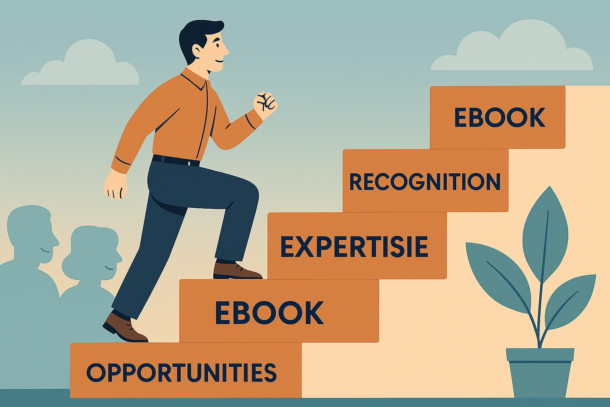
A fundamental difference exists between being an expert and being recognized as an authority in your field. Expertise means what you know and can do. Authority means being recognized for that expertise in ways that create opportunities.
Your expertise alone cannot build the career or business you want in today’s noisy information environment. You must transform that expertise into recognized authority. Thought leadership ebooks provide one of the most effective tools for making this transformation.
Professionals and businesses that thrive in coming years won’t necessarily possess the greatest expertise, but will most effectively share their thinking with the right audiences. Your knowledge becomes exponentially more valuable when packaged in ways that help others succeed.
What unique insights have you developed through your work and experience? What frameworks have you created that could help others navigate challenges? What perspective do you offer that lacks adequate representation in your field?
These questions point to the thought leadership contribution only you can make. Your ebook serves as more than a marketing tool – it’s your opportunity to shape the conversation in your field and create value extending far beyond your direct work with clients or colleagues.
What thought leadership territory will you claim with your ebook?

